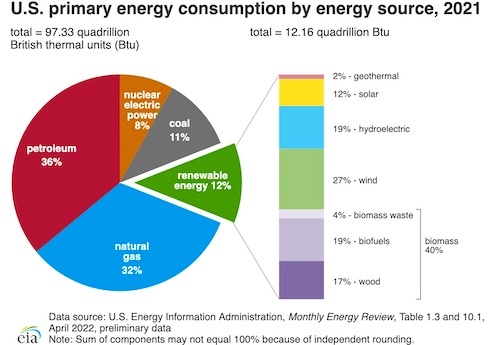
By Paul Quigg, columnist
There seems to be a lot of confusion concerning electricity in my “Fabrication” column. There is a very simple way to clear up the confusion. Sign in to the US Energy Information Administration, and in the search box request “primary energy consumption by energy source.” You will note that electricity is not listed as an energy source. What further proof do you need to be convinced electricity is not a source of energy?
It is perfectly natural to think electricity is an energy source when we refer to so many “electrical” products in our lives. Since the introduction of electricity, we have seen great progress and many conveniences. I can’t imagine what life would be like without it.
Some of the “replies” have been over the top and I would hope they would continue to participate, but a little more civilly. The climate is extremely complicated and there is much we can all learn as we share our opinions.
You will also note on the graph that renewable energy provides 12 percent of our energy and that solar provides 12 percent of the renewables. Multiplying 12 percent by 12 percent we get a solar total of 1.44 percent of our energy. When we talk about solar, we are usually talking about power which is the electrical sector that provides around 25 percent of our energy.
The other sectors are transportation, manufacturing, and residential. All of the goals for renewables in 2030, 2050, etc. are confined to the power sector with no regard to the other three sectors. Consequently, our future goals only involve 25 percent of the problem.
Wind is not a whole lot better, currently providing 3.24 percent of our energy.
Mr. Quigg, a University of Virginia graduate and resident of Luray, has practiced architecture in the Mid-Atlantic region since 1962. As a lifelong environmentalist, in the 70’s he was appalled at the polluted air and water and has dedicated much of his time since in studying and commenting on the environment. He has been published in the Washington Post, the Wall Street Journal and other publications.
•••
PREVIOUS COLUMNS
Tomorrow ~ Who says we have to have industrial solar?
Tomorrow ~ Steady rise of CO2 ‘discouraging’
Tomorrow ~ Warmer weather is not a bad thing
Tomorrow ~ Without subsidies, solar industry would dry up
Tomorrow ~ Thank you planning commission
Planning commission recommends denial of Cape Solar application by unanimous vote



I must amend my Electricity column and admit that I left out a very important source of energy. It is animals. We consume our various foods and our digestive systems produce the energy which gets us through the day. More to follow in future columns.
Thank you for correcting your earlier statement that “there is no such thing as electrical energy.” Your present statement that electricity is a secondary form of energy is correct and a good basis for discussion..
I think you underestimate your readers knowledge and interest in energy and climate matters. For example, many of us understand the limits of solar including the environmental effects of making the panels. But you underestimate the potential and growth. The energy.gov web site you recommend* says “From just 0.34 GW in 2008, U.S. solar power capacity has grown to an estimated 97.2 gigawatts today, ” and “ Since 2014, the average cost of solar PV panels has dropped nearly 70% “ The same site says that solar production is twice what you identify. It is also true that solar adoption in our area is limited by the decision to restrict solar to only 2% of SVEC’s electrical energy sold. it is also limited by SVEC’s poor reimbursements for excess energy they purchase from their customers. However, many also accept that moving to distributed production poses challenges for utilities charged with providing stable power. So yes – it is complicated. But many of your readers are well versed and will respond well to accurate statements. *https://www.energy.gov/eere/solar/solar-energy-united-states
Tom, I believe the readers have various levels of knowledge in climate matters, myself included. I doubt if any one person understands all of it. I could go so far as to say that no one person understands the incredible complexity of our climate system.
The solar production figure I identify is from the US Dept. of Energy and involves all energy consumption not just the electricity sector. When the subsidies for solar are not included in solar costs, the true costs are very high. Just follow the solar industry’s frantic efforts to continue the subsidies.
Present-day solar voltaic technology has very little potential in solving our energy needs. Millions and millions of solar panels and we are now at 1.44 percent of the countries consumption.
Fixed it for you: “Just follow the COAL, OIL, GAS industry’s frantic efforts to continue their subsidies.”
The same energy.gov web site you recommend says that solar has the potential to meet 40% of America’s energy needs within 15 years. https://www.energy.gov/sites/default/files/2021-09/Solar%20Futures%20Study.pdf
Tom, All of the websites, gov., non-gov. have made bold predictions of future solar growth for over 20 years, and they have all failed miserably. I looked for a few minutes at the above website and the study only involves the electrical sector, not the entire energy sector, as you note. This is a common mistake as the electric sector only involves about 25 percent of our energy. This mistake is constantly repeated, totally destroying the validity of their findings.
I’m confused. You direct us to the energy.gov web site as proof for your conclusions and find them in error when their data does not support your conclusions.
I have no recollection of ever finding the energy.gov site in error. You made the accusation, please show me my error.